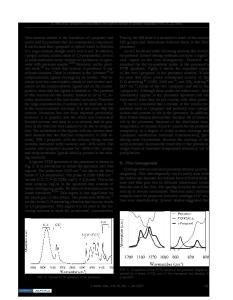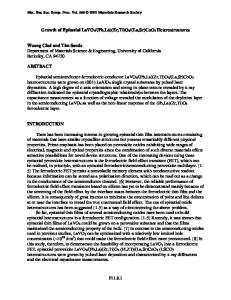207 Pb NMR of PbZrO 3 and PbZr 1-x Ti x O 3 Solid Solutions
- PDF / 432,362 Bytes
- 6 Pages / 612 x 792 pts (letter) Page_size
- 24 Downloads / 447 Views
207
Pb NMR of PbZrO3 and PbZr1-xTixO3 Solid Solutions
Paolo Rossi, Matthew R. Dvorak, and Gerard S. Harbison Chemistry Dept., University of Nebraska, Lincoln, NE 68588-0304 ABSTRACT PbZrO3 undergoes a phase transition to a paraelectric phase at 230°C. During this phase transition the unit cell changes from orthorhombic to cubic. Structural changes of PbZrO3 have been monitored using solid state NMR by measuring the variation in the 207Pb chemical shielding tensor as a function of temperature. The two distinct lead sites show rather different behavior as a function of temperature. The less shielded lead maintains an almost constant asymmetry parameter η = 0.2 from 0°C to 200°C while the more shielded lead resonance becomes more axially symmetric as the temperature is raised going from η = 0.24 at 0°C to η = 0.08 at 200°C. Powder pattern singularities become less distinct near the phase transitions, but the temperature dependence of the chemical shift tensor principal values remains continuous, and there is no evidence of an intervening higher-symmetry phase. At the phase transition, both resonances collapse into a single narrow line characteristic of a nucleus at a high-symmetry site. Results of a preliminary study of the PbZr1–xTixO3 solid solutions by 207Pb solid state NMR are also presented. INTRODUCTION Lead zirconium oxide (PZ) and mixed lead zirconium-titanium oxide (PZT) are perovskite-type materials of considerable technological importance [1]. The common methods of preparation of PZT based materials are sintering at high temperature and sol-gel techniques. In order to obtain materials that exhibit the desired properties, knowledge of condition-dependent structural changes is required. This is a particularly ambitious goal considering the fact that the even the structure determination of simple PZ is still being actively pursued and remains controversial. A large number of crystallographic studies of PZ have been reported in which the investigators arrived at different conclusions about the structure [2,3]. Lately the consensus appears to be that antiferroelectric PZ is orthorhombic with the Pbam space group [4,5]. The difficulties in determining the PZ structure originated largely because of structural disorder and the lack of a standard preparation method that gives uniform, defect-free PZ crystals with low Pb and O vacancies. Given the sensitive nature of the 207Pb nucleus to the surrounding environment, solid state NMR has often been used as a tool to gain structural insights by correlating the values of 207Pb chemical shift to the mean Pb-O distance in PZ and PZ-based compounds [6-9]. 207Pb NMR has also been used for a qualitative examination of the changes in chemical shift as a function of preparation temperature [10]. However, because of the width of the spectrum, distorted and noisy spectra have been the rule rather than the exception, and these distortions have been in some cases sufficient to compromise the measurement of the principal values. Moreover, the dependence of the chemical shift tensor
Data Loading...











